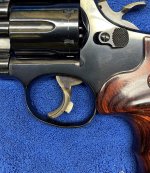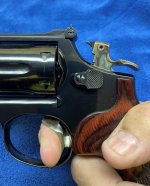The “adjustable” trigger stop is a part of the S&W revolver world that seemingly never gets discussed. I recently bought my first 27-2 and was surprised to find no trigger stop on it. So I fished my 27-5 out of the safe and there wasn’t one on it either. My 6-inch 66-2 has one. I believe that my 14-3 has one.
And these trigger stops can only be adjusted if you go under the side plate — which I cannot imagine that S&W ever intended the end buyer do.
I have heard that some LE organizations would have their armorer preemptively remove these, just in case.
So what is the untold story of the trigger stop? Why do some have them and some do not? Does anyone have theirs adjusted to any benefit?
And these trigger stops can only be adjusted if you go under the side plate — which I cannot imagine that S&W ever intended the end buyer do.
I have heard that some LE organizations would have their armorer preemptively remove these, just in case.
So what is the untold story of the trigger stop? Why do some have them and some do not? Does anyone have theirs adjusted to any benefit?




